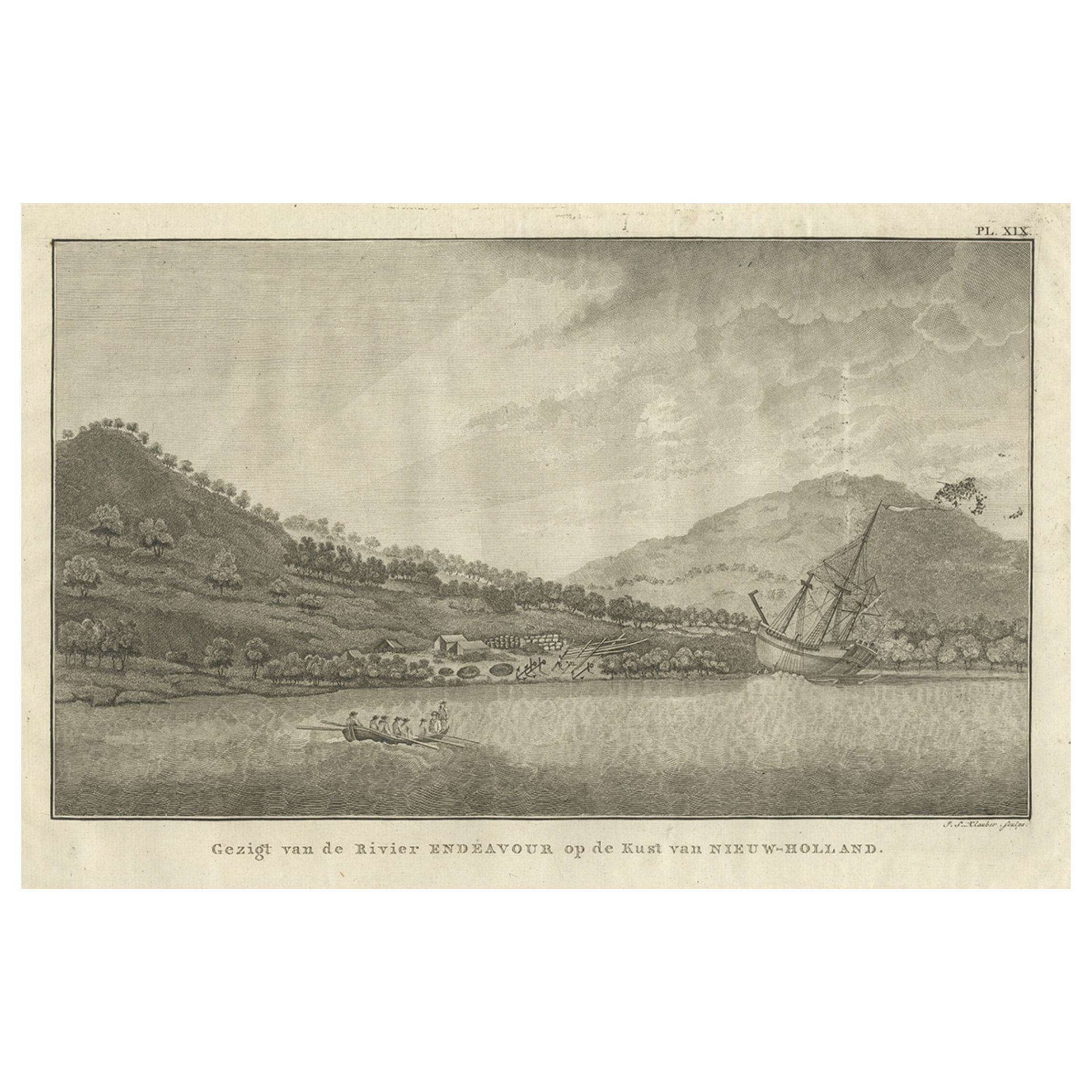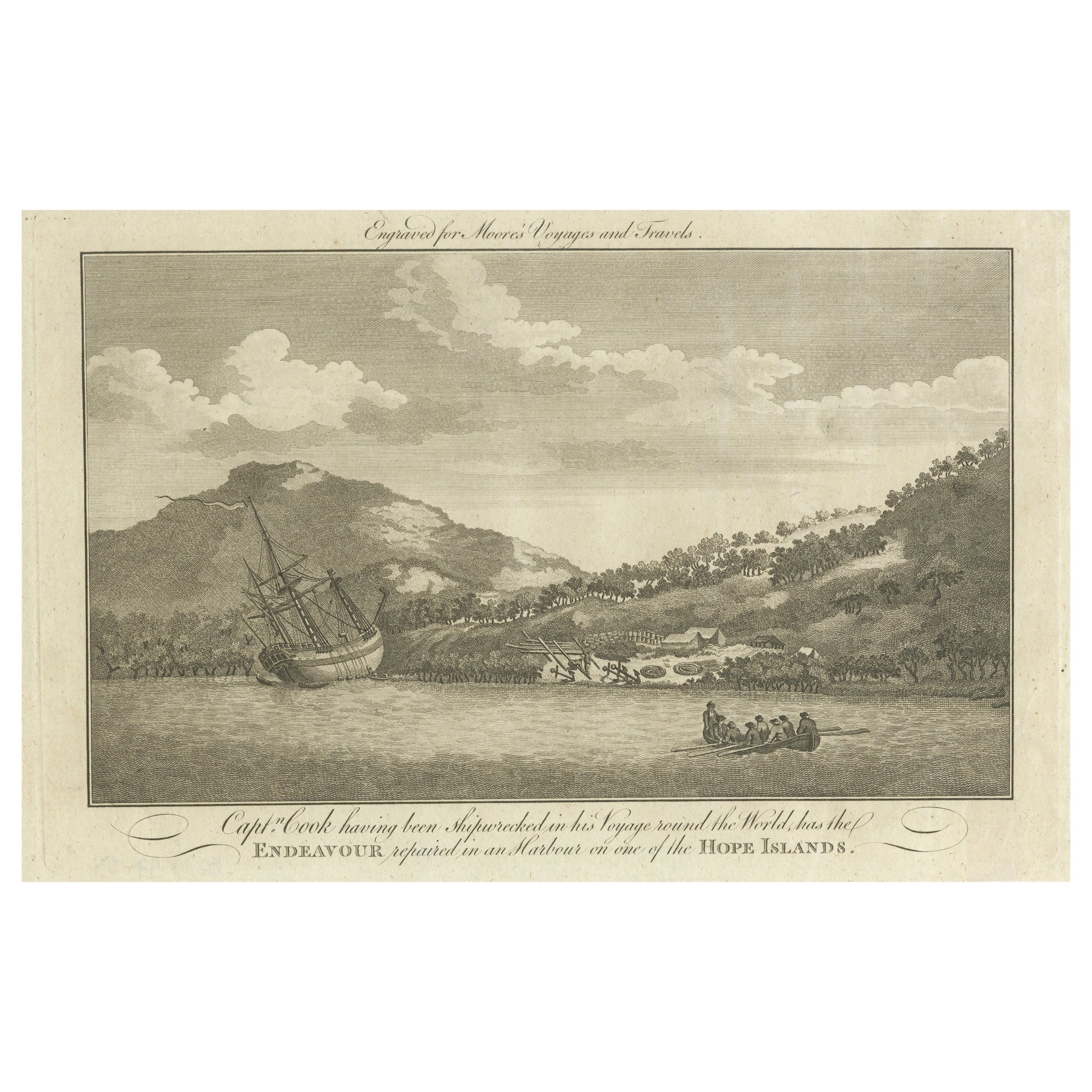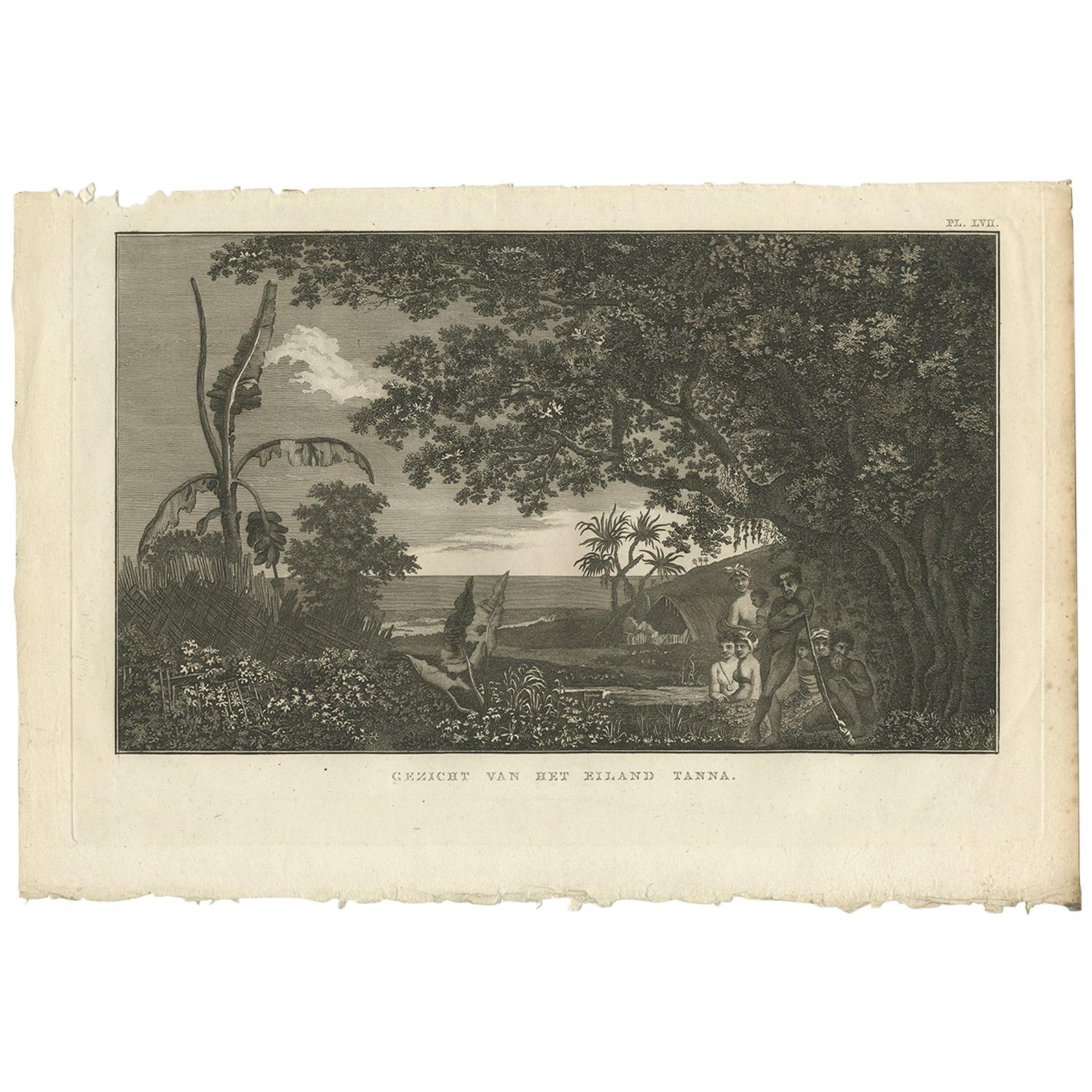Items Similar to Narrow Escape: Captain Cook's Perilous Departure from Erromango, Circa 1790
Want more images or videos?
Request additional images or videos from the seller
1 of 7
Narrow Escape: Captain Cook's Perilous Departure from Erromango, Circa 1790
About the Item
Title: "Narrow Escape: Captain Cook's Perilous Departure from Erromango"
Description: This original antique engraving here on offer presents a dramatic scene titled "The Fortunate Escape of Capt'n Cook from the Furious Natives of Erramango." It portrays Captain James Cook and his crew in a small rowboat, hastily retreating from the shore of Erromango, one of the islands in the Pacific.
The image captures the intensity of the moment, with Cook standing in the stern, commanding the boat's escape, while the crew row vigorously. On the shore, a group of indigenous people, referred to in the title as "furious natives," can be seen in a state of agitation, with some brandishing weapons. The engraving communicates a narrative of conflict and confrontation, which was often part of the European exploration accounts of the time. In the background, Cook's ship waits offshore, under a sky filled with billowing clouds, which adds to the dramatic atmosphere of the scene. This encounter is part of the broader history of European explorers' often tumultuous interactions with the peoples they encountered in the Pacific islands.
- Dimensions:Height: 7.88 in (20 cm)Width: 11.42 in (29 cm)Depth: 0 in (0.02 mm)
- Materials and Techniques:Paper,Engraved
- Period:
- Date of Manufacture:circa 1770
- Condition:Good. Non visible restorations and no foxing or soiling. A light brownish edge below the bottom text, not touching the image or text. Study the images carefully.
- Seller Location:Langweer, NL
- Reference Number:
About the Seller
5.0
Platinum Seller
These expertly vetted sellers are 1stDibs' most experienced sellers and are rated highest by our customers.
Established in 2009
1stDibs seller since 2017
1,928 sales on 1stDibs
Typical response time: <1 hour
- ShippingRetrieving quote...Ships From: Langweer, Netherlands
- Return PolicyA return for this item may be initiated within 14 days of delivery.
More From This SellerView All
- Captain Cook's Encampment in Australia where The Endeavour was Beached, 1803Located in Langweer, NLAntique print Australia titled 'Gezigt van de Rivier Endeavour op de Kust van Nieuw-Holland'. View of an encampent on the shore of the Endeavour river on the coast of Australia where the Endeavour boat was beached. Originates from 'Reizen Rondom de Waereld door James Cook (..)'. HMS Endeavour was a British Royal Navy research vessel that Lieutenant James Cook commanded to Australia and New Zealand on his first voyage of discovery from 1768 to 1771. She was launched in 1764 as the collier Earl of Pembroke, with the Navy purchasing her in 1768 for a scientific mission to the Pacific Ocean and to explore the seas for the surmised Terra Australis Incognita or "unknown southern land". Commissioned as His Majesty's Bark Endeavour, she departed Plymouth in August 1768, rounded Cape Horn and reached Tahiti in time to observe the 1769 transit of Venus across the Sun. She then set sail into the largely uncharted ocean to the south, stopping at the islands of Huahine, Bora Bora, and Raiatea west of Tahiti to allow Cook to claim them for Great Britain. In September 1769, she anchored off New Zealand, becoming the first European vessel to reach the islands since Abel Tasman's Heemskerck 127 years earlier. In April 1770, Endeavour became the first European ship to reach the east coast of Australia, with Cook going ashore at what is now known as Botany Bay. Endeavour then sailed north along the Australian coast. She narrowly avoided disaster after running aground on the Great Barrier Reef, and Cook had to throw her guns overboard to lighten her. Endeavour was beached on the Australian mainland for seven weeks to permit rudimentary repairs to her hull. Resuming her voyage, she limped into port in Batavia in October 1770, her crew sworn to secrecy about the lands that they had visited. From Batavia Endeavour continued westward, rounded the Cape of Good Hope on 13 March 1771 and reached the English port of Dover on 12 July, having been at sea for nearly three years. The ship was largely forgotten after her Pacific voyage, spending the next three years hauling troops and cargo to and from the Falkland Islands. She was renamed in 1775 after being sold into private hands, and used to transport timber from the Baltic. Rehired as a British troop transport during the American War of Independence, she was finally scuttled in a blockade of Narragansett Bay, Rhode Island in 1778. Historical evidence indicates the ship was sunk just north of Goat Island in Newport Harbor, along with four other British transports. Relics from Endeavour are displayed at maritime museums worldwide, including an anchor and six of her cannon. A replica of Endeavour was launched in 1994 and is berthed alongside the Australian National Maritime Museum in Sydney Harbour. The NASA Space Shuttle...Category
Antique Early 1800s Prints
MaterialsPaper
- Ceremonial Tribute to Captain Cook in the Hawaiian Archipelago, circa 1790Located in Langweer, NLTitle: "Ceremonial Tribute to Captain Cook in the Hawaiian Archipelago" Description: This antique print depicts a scene titled "An Offering before Capt'n Cook in the Sandwich Island...Category
Antique Late 18th Century Prints
MaterialsPaper
- Repairing the Endeavour: Captain Cook's Maritime Ordeal at Hope Islands, ca.1770Located in Langweer, NLThe engraving depicts a scene from one of Captain James Cook's voyages. The text below the image reads: "Capt'n Cook having been shipwrecked in his Voyage round the World, his ship E...Category
Antique Late 18th Century Prints
MaterialsPaper
- View of Tanna Island: A Glimpse into Vanuatu from Cook's Voyages, 1803Located in Langweer, NLAntique print titled 'Gezicht van het Eiland Tanna'. This print depicts a view of Tanna Island, Vanuatu. Originates from 'Reizen rondom de Waereld' by J. Cook. Translated by J.D. Pas...Category
Antique Early 19th Century Dutch Prints
MaterialsPaper
- Rare Engraving of New Caledonia & New Hebrides from Capt. Cook's Travels, 1777Located in Langweer, NLAntique map titled 'Chart of Discoveries made in the South Pacific Ocean'. Rare engraving from the official British Admiralty sanctioned edition of the accounts of Cook’s second voyage. All other later copies made of this image by other publishers were unauthorised, usually smaller and inferior in quality. Made after Cook's discovery of the island group on 4 September 1774, which he named New Caledonia...Category
Antique 1770s Maps
MaterialsPaper
- Serene Daily Life in New Caledonia: A Captured Moment from Cook's Voyages, 1784Located in Langweer, NLThis antique engraving titled "The Inhabitants of New Caledonia" appears to be from the accounts of Captain James Cook's travels. The image depicts a scene from New Caledonia, an arc...Category
Antique 1780s Prints
MaterialsPaper
You May Also Like
- Captain Cook's Exploration of Tahiti 18th C. Hand-Colored Map by BellinBy Jacques-Nicolas BellinLocated in Alamo, CAThis beautiful 18th century hand-colored copper plate engraved map is entitled "Carte de l'Isle de Taiti, par le Lieutenant J. Cook" was created by Jacques Nicolas Bellin and publish...Category
Antique Mid-18th Century French Maps
MaterialsPaper
- Pictorialist Photograph Nude Wood Nymph by Charles Cook Circa 1910Located in Rochester, NYPictorialist photograph of nude woman in a forest interior by Charles Cook. Silver print. Circa 1910. Charles J. Cook was a painter and pho...Category
Early 20th Century North American Photography
MaterialsPaper
- Original Antique Print of Papyrus Grass, Circa 1790Located in St Annes, LancashireGreat image of papyrus grass Copper-plate engraving Published C.1790 Unframed.Category
Antique 1790s English Georgian Prints
MaterialsPaper
- Set of 20 Original Antique Architectural Prints, A.G. Cook, circa 1820Located in St Annes, LancashireWonderful set of 20 architectural prints Copper-plate engravings by J. Carter after the original antique architectural drawings by Andrew George Cook. ...Category
Antique 1810s English Palladian Prints
MaterialsPaper
- Original Antique Map of Spain and Portugal, circa 1790Located in St Annes, LancashireSuper map of Spain and Portugal Copper plate engraving by A. Bell Published, circa 1790. Unframed.Category
Antique 1790s English Other Maps
MaterialsPaper
- Set of 4 Original Antique Prints of Monkeys, circa 1790Located in St Annes, LancashireGreat images of monkeys Copper-plate engraving Published C.1790 Unframed.Category
Antique 1790s English Georgian Prints
MaterialsPaper





